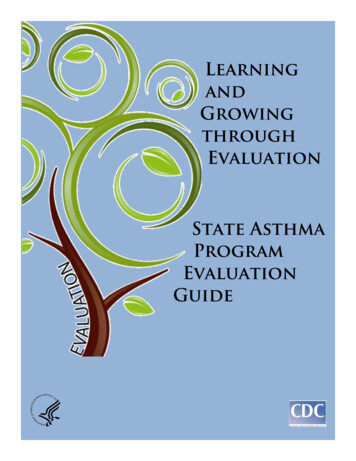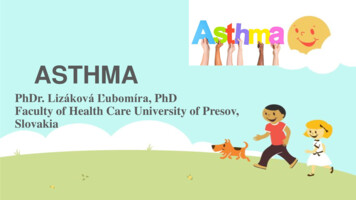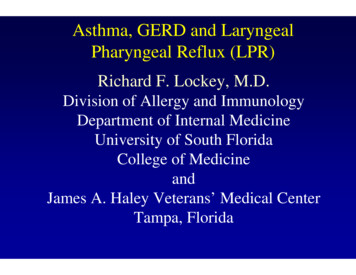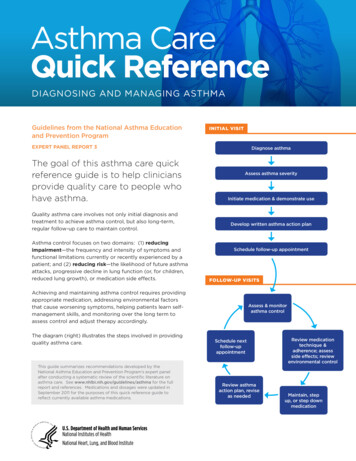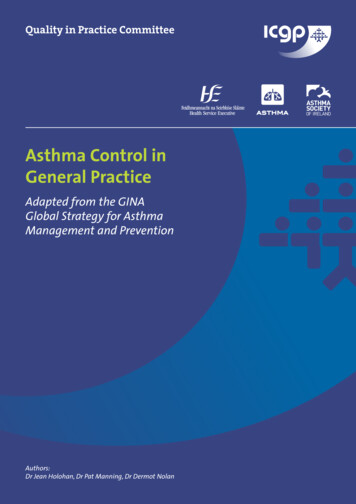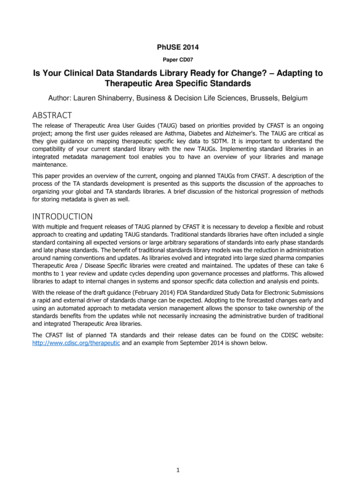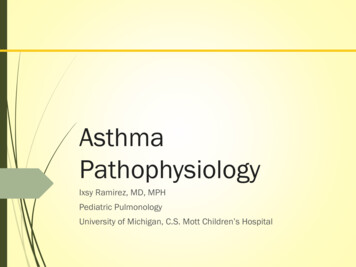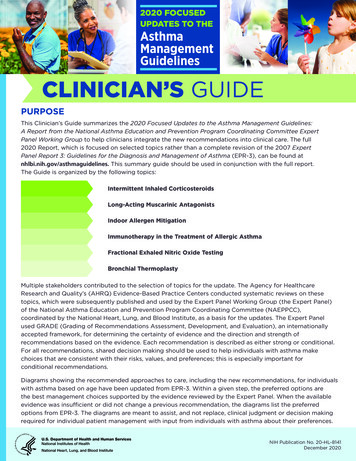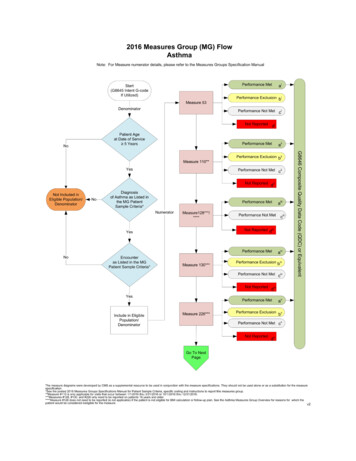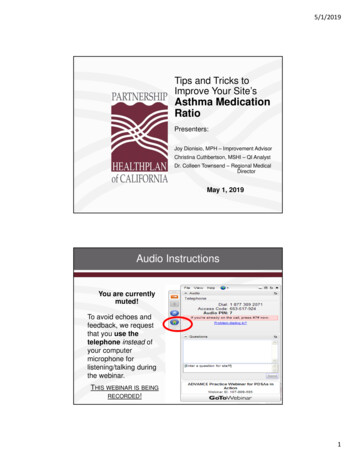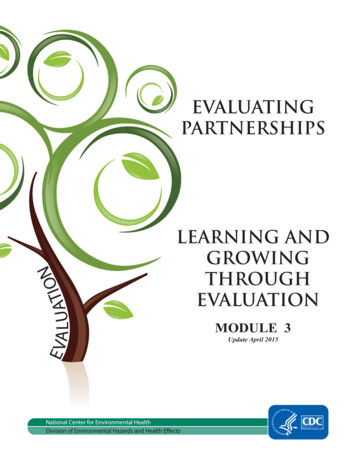
Transcription
EVALUATINGPARTNERSHIPSLEARNING ANDGROWINGTHROUGHEVALUATIONMODULE 3Update April 2015
Learning and Growing through EvaluationModule 3Copies of Learning and Growing through Evaluation: Evaluating Partnerships can be viewed ordownloaded from the following website: http://www.cdc.gov/asthma/program eval/guide.htmSuggested citation: Centers for Disease Control and Prevention. Learning and Growing throughEvaluation: Evaluating Partnerships. Atlanta, GA: Centers for Disease Control and Prevention,National Center for Environmental Health, Division of Environmental Hazards and Health Effects,Air Pollution and Respiratory Health Branch, July, 2014.Centers for Disease Control and Prevention, National Center for Environmental Health, Division ofEnvironmental Hazards and Health Effects, Air Pollution and Respiratory Health Branch Website:www.cdc.gov/nceh/airpollutionThe Evaluation Team in the National Asthma Control Program thanks the following reviewers fortheir careful reading and thoughtful comments on this guide: Debra Hodges (Alabama), AndrewPritchard (Maine), Ava Nepal (Connecticut), and Peter Walton (Oklahoma).The module is based on the work of the CDC State Partnership Evaluation Work Group. Membersincluded Barbara Cowan, Rick Kreutzer, Janet Tobacman (California); Marcie Memmer (Indiana);Bridget Landers (Massachusetts); Rachel Hess-Mutinda, Audrey Regan (Maryland); Erica Fishman(Minnesota); Lisa Jones (New Jersey); Michael Medvesky, Patricia Waniewski (New York);Barbara Hickcox (Ohio); Robert Richardson (Pennsylvania); Rebecca Giles (Utah); Carlyn Orians,Shyanika Rose, Linda Winges (Battelle Memorial Institute); Leslie Fierro, Elizabeth Herman, LianeHostler, Meredith Lucas, Michele Mercier (CDC).
Module 3Asthma Program Evaluation GuideEvaluating PartnershipsTable of ContentsPageState Asthma Program Partnerships 2Applying the CDC Evaluation Framework to Partnership Evaluation 5Applying Step 1 – Engaging Stakeholders in Your Partnership Evaluation 5Applying Step 2 – Describing Your Partnership 7Applying Step 3 – Focusing Your Partnership Evaluation 10Applying Step 4 – Gathering Credible Evidence about Your Partnership 13Applying Step 5 – Justifying Conclusions about Your Partnership 15Applying Step 6 –Using Evaluation Findings to Strengthen Your Partnership 16References 19List of TablesTable 1 Example Partnership Evaluation Questions 12List of FiguresFigure 1 Partnership Concept Map for the National Asthma Control Program 4Figure 2 Partnership Logic Model for Hypothetical State Asthma Program 8Figure 3 Zooming In: Logic Model for a Hypothetical Health Care System Workgroup Reorganization 9Figure 4 Sample Action Plan to Increase Participation in the Partnership byCommunity Members from Priority Populations 18List of AppendicesAppendix A Glossary A-1Appendix B Evidence Base on Effective Partnerships B-1Appendix C Crosswalk of Partnership Concepts with Evaluation Questions and Tools C-1Appendix D Sample Partnership Evaluation Tools D-1Appendix E Text Descriptions of Figures 2 and 3 E-1Evaluating Partnerships
Module 3Asthma Program Evaluation GuideEvaluating PartnershipsAfter reading this section, users should be able to:Describe how partnerships are conceptualized within the context ofstate asthma programsDevelop individual evaluation plans for the partnership component ofa state asthma programImplement a partnership evaluation in a manner that conforms toprofessional evaluation standardsUse evaluation results to strengthen asthma partnershipsPartnerships are critical components of state asthma programs. Partners aid in planning,implementing, and evaluating the interventions that are intended to improve the public’shealth. As an essential part of the infrastructure of state asthma programs, partnershipswarrant ongoing evaluation to enhance their effectiveness.Partnership evaluation can serve many functions. Evaluation of your partnerships can: Assess progress toward goals Improve partnership activities Identify sources of conflict as well as solutions Provide accountability Increase community awareness and supportModule 1, Learning and Growing through Evaluation: State Asthma Program EvaluationGuide, provides guidance for including partnerships as a key program component in the strategicevaluation planning process. The module is also a resource for developing individual evaluationplans.Module 2, Implementing Evaluations, focuses on actually carrying out the evaluation andincludes appendices that provide suggestions for many of the tasks undertaken during anevaluation. This module, Module 3, Evaluating Partnerships, focuses on the particularchallenges that come with assessing the collaborative work states do to diminish the burden ofasthma.In this module we apply the generic strategies presented in the CDC Framework for EvaluatingPublic Health Programs (MMWR, 1999) to the evaluation of state asthma partnerships. For eachstep of the Framework, we illustrate how its principles apply to partnership evaluations. We hopePage 1-1Evaluating Partnerships
Learning and Growing through EvaluationEvaluating Partnershipsthese examples will stimulate your thinking about ways to tailor your own asthma partnershipevaluation so that it is useful, feasible, ethical, and accurate. Please note that this level of indepth evaluation differs from the monitoring that many groups do via an annual partnershipsatisfaction survey.1To frame our thinking about evaluating partnerships, in 2006–2007 the Air Pollution andRespiratory Health Branch convened a joint CDC-state workgroup.2 Specific questions wesought to answer included: What are the critical dimensions of partnerships? How do thesedimensions influence partnership effectiveness? How have others measured these dimensions?In addition to producing the conceptual model around which this module is organized (seebelow), the workgroup compiled a large number of resources for use in evaluating partnerships,and these are included in the appendices. Appendix A is a glossary of terms used in the module; GLOSSARY TERMS arehighlighted in green. Appendix B presents the evidence base on effective partnerships. Appendix C provides a crosswalk of partnership concepts with evaluation questions andtools. Appendix D is a collection of sample partnership evaluation tools that can be used tomeasure partnership concepts.State Asthma Program PartnershipsPublic health has a rich tradition of using PARTNERSHIPSto pursue its goals. Partnerships can have multiple forms andnames, including strategic partners, coalitions, task forces, andnetworks, among many others. Typically, these shared outcomesinclude decreased asthma symptoms, morbidity, and mortality;decreased asthma disparities; improved productivity and qualityof life for people with asthma and their families; and sustainedor improved statewide asthma efforts.Irrespective of the name or form,a core function of a partnership isto facilitate collaboration amongdistinct entities for the purposeof working toward outcomesof mutual interest and poolingabilities, expertise, and resources.Deliberations of the joint CDC-state workgroup members confirmed that state asthmapartnerships are as varied as the programs themselves. All state asthma programs involvepartners in developing and implementing state plans, but there is significant variation inpartnership purpose, membership composition, size, structure, and stage of development. Thissame level of variation may also occur within a single partnership over time.12Research demonstrates a correlation between a member’s level of involvement and member satisfaction. Whileit is clear that member satisfaction is related to continued involvement with the partnership, it is less clearwhether increased member involvement also results in desired (longer term) programmatic outcomesThe CDC-State Partnership Evaluation Workgroup was comprised of representatives from 10 state asthmaprograms and staff from APRHB and Battelle Centers for Public Health Research and Evaluation.Module 3Page 1-2
Module 3Asthma Program Evaluation GuideState asthma partnerships also share many similarities. The workgroup developed thePARTNERSHIP CONCEPT MAP (see Figure 1) to capture and record these commonalities,thereby helping us think systematically about partnerships and how best to evaluate them.The model is built around the assumption that all state asthma programs make decisions aboutpartnership composition, structure, activities, and goals. It further assumes that partnerships thatperform well on these dimensions ultimately will contribute to positive changes in long-termprogrammatic outcomes such as reduced morbidity and mortality and improved quality of lifefor people with asthma. It does not assume that all partnerships will function effectively or thatpartnership development is linear. Key questions to consider are:Who is involved? On the left side of the partnership concept map, we acknowledge the variationin structure that exists across state asthma partnerships, noting that they may be organizedat the state, regional, or local level. Research indicates that, for partnerships to be effective,membership should include people who understand the problem (in this case asthma) and areable to stimulate local responses and solutions.How do they interact? The left side of the partnership concept map also considers how partnersinteract with one another. Research indicates that partnerships with formalized procedures,structures, and roles/responsibilities are more likely to engage members and pool resources.Partnership structures that are action-oriented (e.g., comprised of task forces or strategicpartners) tend to be effective in mobilizing resources and implementing strategies. Additionally,research indicates the importance of leadership, communication, shared vision, positive groupdynamics, and the ability to resolve conflicts.Members are more likely to remain interested when they view the benefits of engagementas outweighing the costs. Benefits typically described by members include: skill acquisition,exposure to new ideas and groups, strengthened ability to meet individual and collective goals,empowerment, capacity building, new relationships, and the opportunity to contribute to a sharedvision. A commitment to self-assessment is also considered important for a partnership.What do they do? In the center of the partnership concept map we list potential roles thatpartners may play. Partners take on a wide variety of roles in state asthma programs, fromcontributing material resources to actively implementing asthma interventions. They may alsodevelop their own knowledge and skills and use these to effect change in the organizations theyrepresent.Page 1-3Evaluating Partnerships
Learning and Growing through EvaluationEvaluating PartnershipsPage 1-4Module 3
Module 3Asthma Program Evaluation GuideWhat are the results? According to the literature, when a partnership performs well, a varietyof partnership-specific outcomes emerge. The broad engagement of partners mobilized to effectchange in multiple community sectors is more likely to lead to sustained environmental changewithin partners’ peer groups and organizations. The strength of networks and relationshipsbuilt by the partnership may be important for sustaining the partnership itself as well as forhelping it achieve long-term programmatic outcomes. Similarly, the ability of the partnership tosecure financial resources for its work may predict its sustainability and its ability to influenceoutcomes.The literature further demonstrates that combining the perspectives, knowledge, and skills ofdiverse partners can enable the partnership to think in new ways, plan more comprehensiveprograms, and strengthen relationships to the broader community. This SYNERGY is believed tobe an important INDICATOR that a partnership will be effective in reaching its ultimate goals.Applying the CDC Evaluation Framework to Partnership EvaluationIn applying the six steps of the CDC Evaluation Framework to evaluating state asthma programpartnerships, we focus on special considerations that pertain to partnerships—for example,which STAKEHOLDERS might you engage because this is a partnership evaluation andnot a surveillance evaluation? For each step, we illustrate the application of the elements inthe partnership concept map to state asthma partnerships, with an emphasis on moving fromplanning to implementation and then to taking action based on the evaluation findings.Applying Step 1 – Engaging Stakeholders in Your Partnership EvaluationMultiple stakeholder perspectives can contribute to a
the partnership concept map to state asthma partnerships, with an emphasis on moving from planning to implementation and then to taking action based on the

